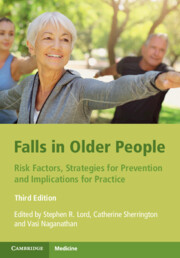Book contents
- Falls in Older People
- Falls in Older People
- Copyright page
- Contents
- Preface
- Contributors
- Part I Epidemiology and Risk Factors for Falls
- Part II Strategies for Prevention
- 16 Exercise to Prevent Falls
- 17 Volitional and Reactive Step Training
- 18 Cognitive-Motor Interventions and Their Effects on Fall Risk in Older People
- 19 Cognitive Behavioural Interventions for Addressing Fear of Falling and Fall Risk
- 20 The Medical Management of Older People at Risk of Falls
- 21 Fall Prevention Interventions for People with Visual Impairment
- 22 Footwear, Orthoses, Walking Aids, Wearable Technology, and Restraint Devices for Fall Prevention
- 23 Environmental Interventions to Prevent Falls at Home and in the Community
- 24 Fall Injury Prevention: Hip Protectors and Compliant Flooring
- 25 Multi-Factorial Fall Prevention Strategies: Where to Next?
- 26 Fall Prevention in Hospitals
- 27 Fall Prevention in Residential Aged Care Facilities
- Part III Implications for Practice
- Index
- References
25 - Multi-Factorial Fall Prevention Strategies: Where to Next?
from Part II - Strategies for Prevention
Published online by Cambridge University Press: 04 November 2021
- Falls in Older People
- Falls in Older People
- Copyright page
- Contents
- Preface
- Contributors
- Part I Epidemiology and Risk Factors for Falls
- Part II Strategies for Prevention
- 16 Exercise to Prevent Falls
- 17 Volitional and Reactive Step Training
- 18 Cognitive-Motor Interventions and Their Effects on Fall Risk in Older People
- 19 Cognitive Behavioural Interventions for Addressing Fear of Falling and Fall Risk
- 20 The Medical Management of Older People at Risk of Falls
- 21 Fall Prevention Interventions for People with Visual Impairment
- 22 Footwear, Orthoses, Walking Aids, Wearable Technology, and Restraint Devices for Fall Prevention
- 23 Environmental Interventions to Prevent Falls at Home and in the Community
- 24 Fall Injury Prevention: Hip Protectors and Compliant Flooring
- 25 Multi-Factorial Fall Prevention Strategies: Where to Next?
- 26 Fall Prevention in Hospitals
- 27 Fall Prevention in Residential Aged Care Facilities
- Part III Implications for Practice
- Index
- References
Summary
There is compelling evidence that a range of risk factors contribute to falls in later life. A natural extension is to think that intervening on multiple risk factors as opposed to a single risk factor for falling might result in a greater reduction in falls. However, the evidence base suggests that interventions that target multiple risk factors are difficult to implement in practice and that the effect varies substantially across populations and practice settings. Multiple risk factor intervention is complex and requires greater commitment from participants and health care professionals than single-component interventions, and costs more to deliver.
- Type
- Chapter
- Information
- Falls in Older PeopleRisk Factors, Strategies for Prevention and Implications for Practice, pp. 386 - 395Publisher: Cambridge University PressPrint publication year: 2021



